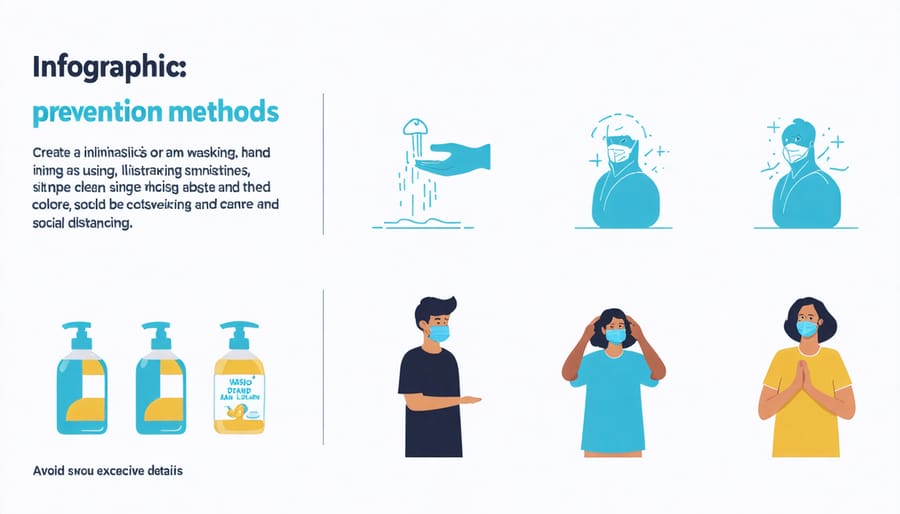Emerging infectious diseases pose an increasingly urgent challenge to public health in the United States, with new pathogens and evolving strains of existing diseases creating unprecedented risks for communities across North America. Recent years have witnessed a concerning uptick in infectious diseases keeping experts vigilant, from antibiotic-resistant bacteria to novel viral threats. Climate change, global travel, and shifting ecosystems have accelerated the spread of these diseases, creating new patterns of transmission that challenge traditional prevention methods. While the U.S. healthcare system maintains robust surveillance and response capabilities, the emergence of diseases like COVID-19 has demonstrated the critical importance of preparedness, early detection, and coordinated public health measures. Understanding these evolving threats and their potential impact on both individual and community health has become essential for healthcare providers, policymakers, and the public alike. This article examines the most significant emerging infectious diseases currently affecting the United States, their transmission patterns, and the innovative approaches being developed to combat them.
Recent Emerging Diseases Crossing Our Borders

New Viral Threats
Recent years have highlighted the dynamic nature of viral threats, with new COVID variants continuing to emerge and challenge public health systems. While vaccination efforts have helped manage these variants, health officials remain vigilant in monitoring their evolution and potential impact on communities.
Beyond COVID-19, several other viral threats have caught the attention of health authorities. The rise in cases of respiratory syncytial virus (RSV) among both children and older adults has prompted increased surveillance and prevention efforts. Additionally, mutations in existing influenza strains have led to concerns about potential seasonal outbreaks that could be more severe than usual.
Health experts are also monitoring the potential spread of viruses previously uncommon in North America. Climate change and shifting environmental patterns have created conditions that could allow certain mosquito-borne viruses to establish themselves in new regions. These include variations of West Nile virus and emerging forms of encephalitis.
Public health organizations emphasize that while these viral threats require attention, most can be managed through proven preventive measures. Regular hand washing, proper ventilation in indoor spaces, staying up to date with recommended vaccinations, and maintaining a strong immune system through healthy lifestyle choices remain effective strategies for protection.
Bacterial Infections of Concern
Antibiotic-resistant bacteria represent one of the most pressing public health challenges in North America. The Centers for Disease Control and Prevention has identified several concerning bacterial threats, including methicillin-resistant Staphylococcus aureus (MRSA) and drug-resistant strains of Streptococcus pneumoniae.
Of particular concern is the emergence of carbapenem-resistant Enterobacteriaceae (CRE), often called “superbugs,” which have developed resistance to most available antibiotics. These bacteria can cause severe infections in healthcare settings and are especially dangerous for people with weakened immune systems.
Another emerging threat is drug-resistant Neisseria gonorrhoeae, which has become increasingly difficult to treat with standard antibiotics. This development has significant implications for public health management and treatment protocols.
The spread of antibiotic-resistant bacteria is often linked to the overuse and misuse of antibiotics in both healthcare and agricultural settings. To address this challenge, healthcare providers are implementing more stringent antibiotic stewardship programs, while researchers work to develop new treatment approaches.
Prevention remains crucial. Simple measures like proper hand hygiene, staying up to date with vaccinations, and using antibiotics only as prescribed can help reduce the spread of resistant bacteria. Healthcare facilities are also implementing enhanced infection control measures to protect patients and staff from these emerging threats.
For those concerned about bacterial infections, maintaining a strong immune system through healthy lifestyle choices is an important preventive strategy.
Risk Factors and Prevention Strategies
Environmental and Lifestyle Factors
Environmental changes and modern lifestyle patterns play significant roles in the emergence and spread of infectious diseases across the United States. Climate change has created more favorable conditions for disease-carrying insects like mosquitoes and ticks to thrive in previously inhospitable regions. Warmer temperatures and changing precipitation patterns have extended these insects’ breeding seasons and expanded their geographical range, increasing the risk of diseases like West Nile virus and Lyme disease.
Urbanization and human encroachment into wildlife habitats have also increased contact between humans and animals, creating more opportunities for zoonotic diseases to spread. As communities expand into formerly wild areas, people face greater exposure to animals that may carry novel pathogens.
Our interconnected world contributes significantly to disease spread. International travel and trade can transport infections across continents within hours, while dense urban living conditions can accelerate transmission within communities. The popularity of exotic pets and wildlife tourism also increases exposure risks to new pathogens.
Modern agricultural practices, including intensive farming and antibiotic use in livestock, can create conditions that promote the evolution of new pathogens and antibiotic-resistant bacteria. Additionally, changes in food production and distribution systems can affect how diseases spread through our food supply.
Personal lifestyle factors, such as increased indoor time, reduced physical activity, and poor nutrition, can weaken immune system function, making individuals more susceptible to emerging infections. Understanding these environmental and lifestyle influences helps public health officials develop more effective prevention strategies and enables individuals to make informed decisions about their health practices.
Personal Protection Methods
Protecting yourself from emerging infectious diseases involves adopting several practical and effective preventive measures. Regular handwashing with soap and water for at least 20 seconds remains one of the most powerful defenses against disease transmission. When soap isn’t available, use an alcohol-based hand sanitizer containing at least 60% alcohol.
Wearing appropriate personal protective equipment (PPE) when necessary is crucial. This includes face masks in crowded indoor spaces or during disease outbreaks, and maintaining physical distance from others who show symptoms of illness. Keep your living and working spaces well-ventilated by opening windows or using air purifiers when possible.
Strengthen your immune system through healthy lifestyle choices. This includes getting adequate sleep (7-9 hours nightly), maintaining regular physical activity, eating a balanced diet rich in fruits and vegetables, and managing stress effectively. Stay up to date with recommended vaccinations and boosters, as they provide essential protection against many infectious diseases.
Practice good respiratory hygiene by covering your mouth and nose when coughing or sneezing, preferably with a tissue or your elbow rather than your hands. Regularly clean and disinfect frequently touched surfaces in your home and workplace, especially during outbreak periods.
Stay informed about current disease outbreaks in your area through reliable health authorities. If you’re planning to travel, research health risks at your destination and take appropriate precautions. Most importantly, if you develop symptoms of illness, stay home and seek medical attention when necessary to prevent spreading infection to others.

Breakthrough Treatments and Therapies
Current Treatment Options
Treatment options for emerging infectious diseases vary depending on the specific pathogen and severity of infection. Healthcare providers typically focus on managing symptoms while supporting the body’s natural immune response. For bacterial infections, antibiotics remain a primary treatment method, though antimicrobial resistance is an increasing concern that requires careful consideration when understanding medical conditions and their appropriate treatments.
Antiviral medications play a crucial role in treating viral infections, though they’re not effective against all viruses. For instance, COVID-19 treatment now includes targeted antiviral drugs like Paxlovid, particularly for high-risk patients. Supportive care, including rest, hydration, and fever management, remains essential for most infectious diseases.
In severe cases, hospitalization may be necessary for intensive monitoring and treatment. This can include oxygen therapy, intravenous fluids, or specialized medications depending on the infection. Some emerging diseases may require experimental treatments or participation in clinical trials when standard treatments aren’t available.
Prevention remains equally important as treatment. Vaccines, when available, offer significant protection against many infectious diseases. Healthcare providers may also recommend preventive medications (prophylaxis) for individuals at high risk of exposure or severe complications.
Regular monitoring and follow-up care ensure treatment effectiveness and help prevent potential complications or disease spread within communities.
Future Treatment Possibilities
Medical researchers and scientists are making significant progress in developing new treatments for emerging infectious diseases. Several promising approaches are currently in various stages of clinical trials, offering hope for more effective responses to future outbreaks.
Advances in antiviral medications show particular promise, with researchers developing broad-spectrum antivirals that could potentially treat multiple types of viral infections. These medications work by targeting common features shared by different viruses, making them valuable tools for addressing new and emerging threats.
Immunotherapy is another exciting frontier, with scientists working on treatments that boost the body’s natural immune response to fight infections more effectively. This includes the development of therapeutic antibodies and immune system modulators that can be quickly adapted to target new pathogens.
Gene editing technologies, such as CRISPR, are being explored as potential tools for developing targeted treatments. These innovations could lead to more precise and effective therapies while reducing side effects.
Researchers are also investigating new vaccine platforms that can be rapidly modified to address emerging threats. These include mRNA vaccines and other adaptable technologies that proved successful during the COVID-19 pandemic.
Additionally, artificial intelligence is being used to accelerate drug discovery and predict potential disease outbreaks, helping healthcare systems prepare more effective treatment responses. These technological advances, combined with traditional research methods, are creating a more robust framework for addressing future infectious disease challenges.
Building a Strong Immune System

Nutrition and Exercise
A balanced diet and regular exercise play crucial roles in maintaining a strong immune system, which is essential for protecting against emerging infectious diseases. Focus on consuming a variety of colorful fruits and vegetables rich in antioxidants, particularly citrus fruits, berries, and leafy greens. Include lean proteins, whole grains, and healthy fats in your daily meals to support optimal immune function.
Aim for 150 minutes of moderate physical activity per week, such as brisk walking, cycling, or swimming. Regular exercise helps improve circulation, reduce inflammation, and enhance the body’s natural defense mechanisms. However, avoid overtraining, as excessive exercise can temporarily suppress immune function.
Stay hydrated by drinking plenty of water throughout the day, and consider incorporating immune-supporting herbs and spices like garlic, ginger, and turmeric into your meals. Limit processed foods, added sugars, and alcohol, as these can weaken immune response.
Remember that adequate sleep and stress management are equally important components of maintaining strong immunity. Consider activities like yoga or meditation to help reduce stress levels while supporting physical fitness.
Mental Health and Immunity
Research increasingly shows that mental health plays a crucial role in our body’s ability to fight off infectious diseases. When we experience chronic stress, anxiety, or depression, our immune system’s effectiveness can decrease significantly, making us more susceptible to emerging infectious diseases.
Stress hormones like cortisol, when consistently elevated, can suppress immune function and reduce our body’s production of disease-fighting white blood cells. This connection highlights why maintaining good mental health is just as important as physical preventive measures.
Practical ways to support both mental wellness and immunity include regular exercise, adequate sleep, and stress-management techniques such as meditation or deep breathing exercises. Social connections also play a vital role, as positive relationships help reduce stress levels and boost immune function.
For Canadians concerned about emerging infectious diseases, incorporating mental health care into their preventive strategy is essential. Simple daily practices like maintaining a consistent sleep schedule, spending time in nature, and seeking professional support when needed can help strengthen both mental resilience and immune response.
Emerging infectious diseases present ongoing challenges to public health in the United States, with implications that directly affect Canadian health security. As we’ve explored throughout this article, staying informed and taking preventive measures are crucial steps in protecting ourselves and our communities.
Key takeaways include the importance of maintaining good hygiene practices, staying up-to-date with vaccinations, and following public health guidelines. Regular handwashing, proper respiratory etiquette, and staying home when sick remain our first line of defense against infectious diseases.
To protect yourself and others, consider these actionable steps:
– Monitor reliable health sources for updates on emerging diseases
– Keep your immunizations current, including annual flu shots
– Create an emergency preparedness kit
– Develop healthy habits that boost your immune system
– Stay informed about cross-border health advisories
Remember that infectious diseases don’t recognize borders, making international cooperation and awareness essential. By staying vigilant and following public health recommendations, we can better prepare for and respond to emerging health threats. If you’re planning travel to the United States, consult with healthcare providers about specific precautions and necessary vaccinations.
Working together as a global community, while taking individual responsibility for our health, offers the best strategy for addressing emerging infectious diseases and maintaining public health security.

